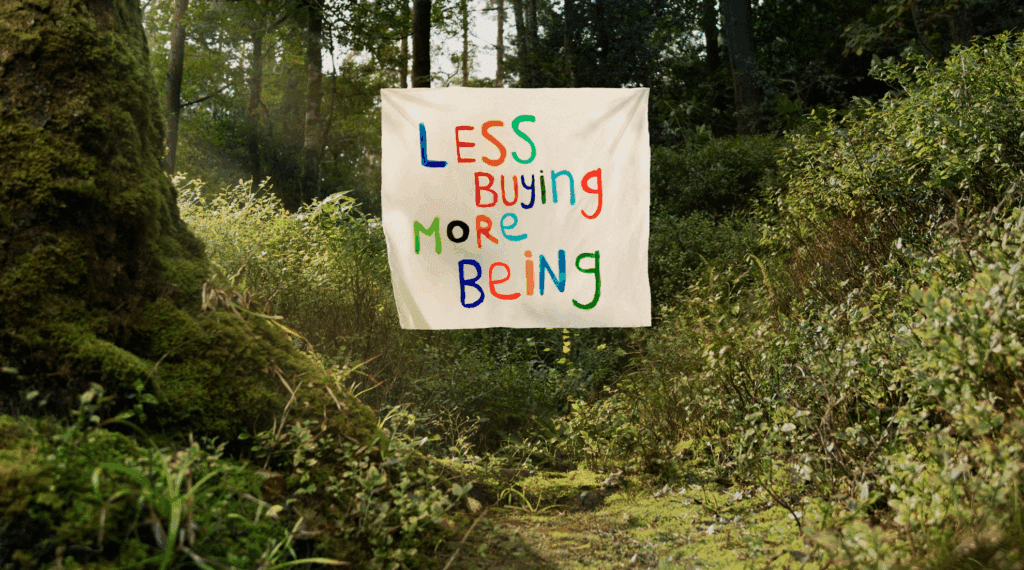The clothes on our backs are unravelling our ecosystems. From the forests felled for viscose to the rivers running blue with dye, fashion’s footprint stretches far beyond shop windows, Instagram posts and catwalks. Every year, billions of garments are made, shipped, and discarded—driving emissions, polluting waterways, and depleting resources at a pace our planet can’t replenish. Despite growing collective understanding, environmental damage is accelerating alongside the pace of production. As many work to disrupt these dangerous trends, consumption of clothing and footwear is expected to more than double by 2030.
The Role of Advertising
This problem isn’t an accident. Fashion advertising is a systemic driver of textile overconsumption—pushing high-polluting products and brands into our feeds and public spaces at a relentless pace. Globally, the fashion industry spends billions every year to keep demand in overdrive, flooding us with reasons to buy more, faster. Scroll any social media app for a few seconds and you’ll spot it: the drop, the discount, the must-have. Advertising is the engine of fashion overconsumption-hooking our attention, triggering “buy now” impulses, co-opting scarcity mindsets and turning curiosity into landfills full of barely worn clothes.
This cultural surround-sound doesn’t just influence purchases—it shapes the norms we live by. When more and more of the cues we see equate happiness with consumption, overbuying isn’t a glitch in the system; it is the system. And it’s accelerating: in 2022, the average EU citizen bought 19 kg of clothing, footwear, and household textiles—up from 17 kg in 2019, the equivalent of a large suitcase per person, every year. If we want to hit the brakes on fashion’s destructive pace, we must rethink the tactics and stories that fuel it—not just eradicating harmful practices, but actively rewriting our social norms.
Doing Less Harm: Regulating Advertising
How do we begin to redesign an industrial-scale attention economy that monetises aspiration and hard-wires “buy now” reflexes into our everyday lives? The current fundamental structure of the advertising sector is heavily influenced by short-term profit incentives and immediate financial returns which often override longer term decision-making. Impactful regulation is needed to accelerate the transition, creating a healthier media landscape and a level playing field to future-proof the advertising industry.
History shows targeted policy interventions are effective. Tobacco advertising bans have reduced smoking rates worldwide, with the WHO citing them as one of the most cost-effective ways to curb demand. After the US cigarette ad ban, sales fell sharply. In the UK, the Transport for London Healthier Food Advertising Policy restricted high-fat, salt, and sugar food ads—cutting household purchases of unhealthy food without hurting ad revenue, and delivering major health benefits, with projected NHS savings of £200 million. Yet industries causing significant environmental damage, including ultra-fast fashion, remain largely unregulated.
France has taken decisive steps to address this issue, passing a bill to ban advertising for ultra-fast fashion brands and sanction influencers who promote them. This aligns with shifting consumer sentiment, evident in the rise of “deinfluencing” trends where people actively discourage unnecessary purchases.
The lesson is clear: targeted restrictions can reduce harm without collapsing the sector. The next step is not only to limit harmful advertising, but to channel the industry’s creative power toward promoting the lifestyles we urgently need to normalise.
Doing More Good: New Stories & Narratives
Restricting harmful advertising is only half the solution. We must also unlock the industry’s potential as a force for cultural transformation—replacing what we don’t want with what we urgently need. Right now, just 6% of ads feature sustainable behaviours — a staggering underuse of one of the most powerful storytelling tools in modern society. If advertisers can fuel desire for fast fashion, they can just as effectively create desire for low-carbon lifestyles—making them visible, aspirational, and mainstream.
This means more than swapping product messages; it’s about shifting the narrative at the heart of the industry. Advertising can close the widening gap between people and the natural world—helping to address a 60% decline in nature connectedness—by redirecting attention away from hyper-consumption and toward connection, creativity, and wellbeing. It can normalise ways of living that bring us back into balance with each other and the planet.
Purpose Disruptors – an award-winning non-profit on a mission to transform the advertising industry to work in harmony with the natural world – has launched two initiatives, which show what this could look like in practice:
- Good Life 2030 – A reimagining of what a “good life” could mean in a truly sustainable world, this project seeks to shift the prevailing narrative of a “good life” that is currently centred around wealth, status, and excessive consumption. Instead, it promotes a new vision—based on citizen research—that focuses on deeper connections to self, others, and to nature. Most recently (with funding from the Irish Government via Creative Ireland) ten competing agencies joined forces to create a national campaign as an alternative to Black Friday—Less Buying, More Being. It reached 3.5 million people (80% of the population), encouraging connection over consumption. Explore more here.
- Agency for Nature – A first-of-its-kind pop-up creative agency dedicated to all life on Earth, pairing rising creative talent with media platforms to make nature as visible and compelling as a global fashion campaign. Its mission: close the gap between culture and nature, especially among young, urban audiences. Explore more here.
Both projects prove the same point: when directed toward the right goals, advertising can be a cultural accelerator for climate action, not just a driver of overconsumption.
Looking to the Future
Advertising has the creative firepower and cultural know-how to make sustainable lifestyles as desirable as catching the latest sneaker drop. With effective regulation and policy leadership, the sector could not only help curb the overproduction and overconsumption driving fashion’s environmental toll, but also evolve into a force for genuine good. Done well, this would catalyse changes in citizen mindsets and behaviours, resetting cultural norms away from high-polluting, hyper-consumerist lifestyles and toward sustainable lifestyles—where human wellbeing, and environmental health are front and centre. The creative storytelling power of advertising can, and should be leveraged to build a world where people and the planet thrive together.








